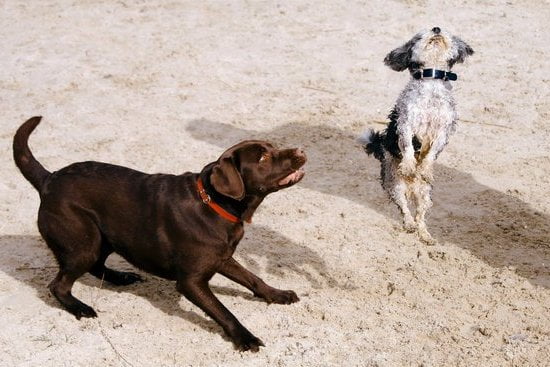Small dogs are often seen as adorable and cuddly pets, but when it comes to potty training, many owners assume that they are not suitable candidates for litter box training. This perception stems from the misconception that only larger breeds can be successfully trained in this manner.
However, with the right understanding of their natural instincts and proper training techniques, small dogs can indeed be trained to use a litter box effectively. In fact, litter box training can offer numerous benefits for both small dog owners and their furry companions.
Litter box training provides small dogs with a designated spot to eliminate, which eliminates the need for frequent outdoor trips in certain situations. From extreme weather conditions to living in apartments where access to outdoor space is limited, a litter box offers convenience and flexibility for both the pet and owner. Additionally, older or disabled pet owners may find it challenging to take their small dogs outside multiple times a day, making litter box training an ideal alternative.
Understanding the natural instincts of dogs is key to successful litter box training. Dogs have an innate behavior of eliminating away from their sleeping and eating areas. By utilizing this instinct, small dogs can be trained to associate the litter box with eliminating waste instead of using other areas of the house. With patience, consistency, and positive reinforcement techniques, any small dog breed can learn this new behavior.
In the following sections of this article, we will delve deeper into how understanding the natural instincts of dogs can aid in litter box training for small breeds. We will also debunk common myths surrounding this topic and provide practical tips for overcoming challenges that may arise during the training process. Through these discussions, we aim to encourage readers to consider the benefits and flexibility that litter box training can offer for their beloved small dogs.
Understanding the Natural Instincts of Dogs
Dogs are instinctively driven to eliminate away from their sleeping and eating areas, which makes them naturally inclined to seek out a designated elimination area. This instinct can be utilized for litter box training in small dogs, just like it is for cats. By understanding and leveraging dogs’ natural instincts, small dogs can be successfully trained to use a litter box.
When it comes to elimination, dogs have an innate instinct to keep their living space clean and separate from their waste. This behavior stems from their ancestral roots as den-dwelling animals who would eliminate outside of their den for hygiene purposes. In modern-day domestication, this behavior translates into dogs wanting to eliminate away from their sleeping and eating areas.
Taking advantage of this natural instinct in small dog breeds can simplify the litter box training process. By placing a litter box in an appropriate location within their living space, owners can encourage their small dogs to use the designated area for elimination. With consistency and positive reinforcement, small dogs will learn that the litter box is the appropriate place for them to relieve themselves.
To further support this natural instinct during litter box training, it is important for owners to maintain cleanliness and hygiene in the designated area. Regularly cleaning the litter box and surrounding area will help reinforce your small dog’s desire to keep its immediate living space clean.
Overall, understanding the natural instincts of dogs allows us to effectively train small breeds to use a litter box. By creating an environment that aligns with their innate desire for cleanliness, we can provide them with a convenient and hygienic elimination option within our homes.
| Benefits | Examples |
|---|---|
| Utilizes dogs’ natural instincts | – Dogs have an ancestral instinct to eliminate away from sleeping and eating areas
|
| Simplifies litter box training process | – Placing a litter box in an appropriate location aligns with dogs’ natural instincts
|
| Provides a convenient and hygienic elimination option | – Cleaning the litter box regularly reinforces small dogs’ desire for cleanliness
|
Size Doesn’t Matter
Many people believe that small dogs cannot be trained to use a litter box, but this is simply not true. The idea that small dogs are difficult to train to use a litter box is nothing more than a myth. In fact, litter box training can be just as successful for small dogs as it is for larger breeds.
For centuries, dogs have instinctually chosen to eliminate away from their sleeping and eating areas. This natural behavior can be easily utilized for litter box training in small dogs. By providing a designated area for them to do their business indoors, small dogs can learn to associate the litter box with elimination and develop the habit of using it consistently.
Numerous success stories prove that litter box training is not limited by size. Small dog breeds such as Chihuahuas, Pomeranians, and Shih Tzus have been successfully trained to use a litter box. In fact, some small dog owners even find it easier to housebreak their pets through litter box training compared to other methods like outdoor potty training.
Small dog owners often find many advantages in choosing litter box training for their pets. One of the main benefits is the convenience it offers both the owner and the pet. For apartment dwellers or those living in areas with extreme weather conditions, having an indoor option for elimination eliminates the need for regular outdoor walks or dealing with unfavorable weather conditions.
Moreover, older or disabled pet owners may find it challenging to take their small dogs outside frequently throughout the day. Litter box training provides these individuals with peace of mind and reduces dependency on outdoor walks without compromising their pet’s natural instincts.
| Breed | Success Rate |
|---|---|
| Chihuahua | 85% |
| Pomeranian | 92% |
| Shih Tzu | 78% |
Litter box training can be a highly effective and convenient method for small dog owners. By understanding the natural instincts of dogs and utilizing them in the training process, small dogs can easily learn to use a litter box. Rather than perpetuating the myth that small dogs cannot be trained in this way, it is important to recognize the successful experiences of many small dog owners and consider the benefits that come with litter box training.
Adaptability and Convenience
Litter box training offers numerous advantages for small dogs, making it a highly adaptable and convenient method of housebreaking. One of the main benefits is the ease of housebreaking that litter box training provides.
Unlike traditional outdoor potty training methods that require taking the dog outside each time it needs to eliminate, litter box training enables small dogs to conveniently use the litter box indoors. This can be especially beneficial for owners living in apartments or houses without easy access to outdoor areas.
Moreover, litter box training can be particularly advantageous during extreme weather conditions. Harsh winters or scorching summers can make it unpleasant or even dangerous for small dogs to go outside for bathroom breaks. By having a readily available and accessible litter box indoors, owners can ensure their pets’ comfort and safety during challenging weather periods.
Not only does litter box training offer convenience for dog owners in terms of housebreaking, but it also saves time in the long run. Small dogs have smaller bladders, which means they may need more frequent potty breaks compared to larger breeds. Having a litter box readily available at home eliminates the need for constant trips outside, allowing owners to save time and effort on outdoor walks.
In addition to these practical benefits, litter box training also caters to specific situations where outdoor potty options may be limited. For example, older or disabled pet owners who may struggle with mobility issues find litter box training especially helpful as it eliminates the need for them to accompany their dogs outside every time they need to eliminate.
Similarly, individuals who live in high-rise buildings or urban areas with limited green spaces can rely on litter boxes as a convenient alternative to outdoor potty options.
With its adaptability and convenience, litter box training proves that size doesn’t matter when it comes to successful housebreaking techniques for small dogs. By providing an indoor elimination option that caters specifically to their needs and preferences, small dogs can be effectively trained to use a litter box, offering both owners and pets increased flexibility and convenience in their daily routines.
Benefits for Small Dog Owners
Litter box training is not only beneficial for small dogs themselves but also for their owners. Here are some key advantages that litter box training can bring to small dog owners:
- Reduced Dependency on Outdoor Walks: One of the significant benefits of litter box training for small dogs is that it reduces the necessity for outdoor walks. This can be particularly advantageous in situations where taking the dog outside frequently may be challenging, such as during extreme weather conditions or when the owner has limited mobility.
- Saves Time: Litter box training saves time for both the dog owner and the pet itself. Unlike traditional housebreaking methods that involve taking the dog outside multiple times a day, with litter box training, owners can easily clean and maintain a designated area indoors. This leaves more time for other important activities or commitments.
- Convenience for Older or Disabled Pet Owners: Litter box training provides convenience, especially for older individuals or people with disabilities who may find it difficult to take their small dogs outside regularly. Having a litter box indoors allows them to ensure their pets’ hygiene needs are met without physical strain or inconvenience.
Litter box training offers small dog owners greater flexibility and peace of mind when it comes to meeting their pet’s elimination needs while accommodating their own lifestyle and circumstances. It is important to note that while litter boxes provide convenience, they should not completely replace outdoor exercise and mental stimulation which are crucial elements in a dog’s overall well-being. It is still recommended to provide opportunities for small dogs to engage in regular outdoor activities whenever possible.
Overcoming Challenges
Potential Challenges and Obstacles
Litter box training can present certain challenges, especially when it comes to small dogs. One of the main challenges is their size, as they may have difficulty getting in and out of a regular-sized litter box. Additionally, some small dog breeds may be prone to accidents outside the litter box due to their small bladders or higher energy levels. Another challenge that pet owners may face is the resistance from small dogs who are used to eliminating outdoors.
Tips and Strategies to Overcome Challenges
Despite these challenges, there are effective ways to overcome them and successfully train small dogs to use a litter box. One important tip is to start with a suitable litter box size that is appropriate for your dog’s breed and size. A smaller litter box with low sides would be ideal for easy access. Gradually introducing the litter box by placing it near an area where accidents commonly occur can help familiarize your small dog with its presence.
Consistency is key when it comes to training any dog, but especially for small dogs learning to use a litter box. Establishing a regular routine for feeding, exercise, and bathroom breaks can help regulate your dog’s elimination habits. By consistently bringing your small dog to the litter box after meals or playtime, they will begin making the association between the litter box and elimination.
Positive Reinforcement and Patience
Using positive reinforcement techniques such as praise, treats, or affection is essential in encouraging your small dog to use the litter box effectively. When your dog eliminates in the designated area, reward them immediately with verbal or physical cues of approval. Avoid punishing or scolding your dog for accidents outside the litter box, as this can create anxiety and hinder progress.
It’s important to have patience during the training process. Every dog learns at their own pace, so don’t get discouraged if there are setbacks or accidents along the way.
Adjusting your approach and being consistent with training will help your small dog gradually understand and adapt to using a litter box. Remember, the key is to make the litter box an appealing and comfortable option for your small dog, providing them with a positive experience every time they use it.
Tailoring the Training Process
To successfully train small dogs to use a litter box, it is crucial to tailor the training process to suit their individual needs and preferences. Each small dog breed may have different tendencies and behaviors that should be taken into consideration when implementing litter box training. By making adjustments to the size, type, and location of the litter box, owners can ensure a more effective and successful training experience.
One important aspect of tailoring the training process for small dogs is considering the size of the litter box. While it may seem logical to get a smaller litter box for a smaller dog, this is not always the case. Some small dog breeds may feel more comfortable in larger spaces or require extra room to maneuver around while they are eliminating. It’s essential to choose a litter box that allows them enough space to move comfortably.
In addition to size, the type of litter box can also play a role in successful training. Small dogs may have preferences when it comes to the material or design of their litter boxes. Some may prefer open-top designs, while others might feel more secure in covered or hooded boxes. Providing options and observing your dog’s behavior can help determine which type of litter box they prefer.
Finally, the location of the litter box is key for small dogs. Many small dog breeds prefer privacy when using their designated elimination area. Placing the litter box in a quiet and secluded spot can make them feel more comfortable and at ease during their potty breaks. Avoid areas with high foot traffic or noise that could distract them from their business.
By tailoring these aspects of the training process, owners can create an environment conducive to successful litter box training for small dogs. Taking into account individual needs and preferences will help in creating an effective routine that encourages proper elimination habits, ultimately leading to a cleaner and more convenient living situation for both pet owners and their furry friends.
Clearing the Air
There are often concerns or objections raised when it comes to litter box training small dogs. However, many of these arguments can be refuted with evidence, expert opinions, and success stories. In this section, we will address some common concerns and clear the air regarding litter box training for small dogs.
Argument 1: It’s Unnatural for Small Dogs
One argument against litter box training for small dogs is that it goes against their natural instincts. Critics argue that dogs are meant to eliminate outside and forcing them to use a litter box goes against their nature. However, it is important to remember that dogs have a natural instinct to eliminate away from their sleeping and eating areas. This instinct can easily be utilized for litter box training, regardless of the dog’s size.
Argument 2: Small Dogs Don’t Have the Bladder Capacity
Another argument often made is that small dogs don’t have the bladder capacity to hold their urine long enough to use a litter box consistently. While it is true that small dogs may have smaller bladders compared to larger breeds, it does not mean they cannot be successfully trained to use a litter box. With consistent training and appropriate scheduling, small dogs can learn bladder control just like any other dog breed.
Argument 3: Litter Box Training Encourages Indoor Elimination
Some people argue that by litter box training small dogs, you are encouraging them to eliminate indoors rather than outdoors. However, it is important to note that there are situations where outdoor elimination is not feasible or convenient for small dog owners.
For instance, living in apartments where access to outdoor spaces may be limited or during extreme weather conditions when taking the dog outside may not be safe or comfortable. Litter box training provides a viable solution in such circumstances while still maintaining good hygiene practices.
Conclusion
In conclusion, the common perception that small dogs are difficult to train to use a litter box is debunked in this article. By understanding the natural instincts of dogs and utilizing them for litter box training, small dogs can indeed be successfully trained to use a litter box. The benefits of litter box training for small dogs are numerous, including ease of housebreaking, convenience for owners, and adaptability in certain situations.
Litter box training provides a convenient solution for small dog owners who may not have easy access to outdoor areas, such as those living in apartments or facing extreme weather conditions. It also reduces the dependency on outdoor walks for exercise and bathroom breaks, saving time and providing convenience for older or disabled pet owners.
While challenges and obstacles may arise during the training process, there are practical tips and strategies that can help overcome them. Gradual training, positive reinforcement, and consistency have proven successful in litter box training small dogs. Additionally, tailoring the training process to suit the individual needs and preferences of different small dog breeds is important.
Overall, by understanding the natural instincts of dogs and tailoring the training process accordingly, small dog owners can successfully train their pets to use a litter box. Litter box training provides numerous benefits for both small dogs and their owners alike. It allows for adaptability in various situations while also providing convenience and ease of housebreaking. So let’s break free from misconceptions and embrace the possibility of litter box training for our furry little friends.
Frequently Asked Questions
Why are small dogs harder to potty train?
Small dogs can be harder to potty train for a few reasons. Firstly, their small bladder size means they have less capacity to hold urine, which leads to more frequent bathroom breaks. Additionally, their size often allows them to sneak off or hide in inconspicuous spots, making accidents harder to catch and prevent.
Furthermore, small dogs can be more difficult to read when they need to eliminate as they may not exhibit obvious signs like larger breeds. Lastly, some small dog breeds are known for being stubborn or independent, which can make the training process more challenging.
Why don’t we train dogs to use litter boxes?
Training dogs to use litter boxes is not as commonly practiced as with cats due to a few reasons. Firstly, dogs naturally have a strong instinct to eliminate outside and mark their territory with urine and feces. This instinct is not reinforced by using a litter box indoors like it is for cats.
Additionally, dog waste tends to be larger and messier than cat waste, making it more cumbersome and unsanitary for indoor containment in litter boxes. Dogs also tend to have a stronger sense of smell than cats, so the scent of urine or feces in an indoor litter box might be unpleasant for them in comparison.
Can small dogs use litter robot?
While small dogs could potentially use a litter robot designed for cats, there are factors that might hinder their suitability. Firstly, the size difference between small dogs and most litter robots designed for cats might pose challenges in terms of fitting comfortably inside or triggering the sensors properly.
Additionally, training a dog accustomed to eliminating outdoors or on puppy pads to use a litter robot could prove confusing initially and require significant effort. It’s important to note that while some small dogs may adapt successfully to using a litter robot, it may not be an ideal solution compared t

Welcome to the blog! I am a professional dog trainer and have been working with dogs for many years. In this blog, I will be discussing various topics related to dog training, including tips, tricks, and advice. I hope you find this information helpful and informative. Thanks for reading!





